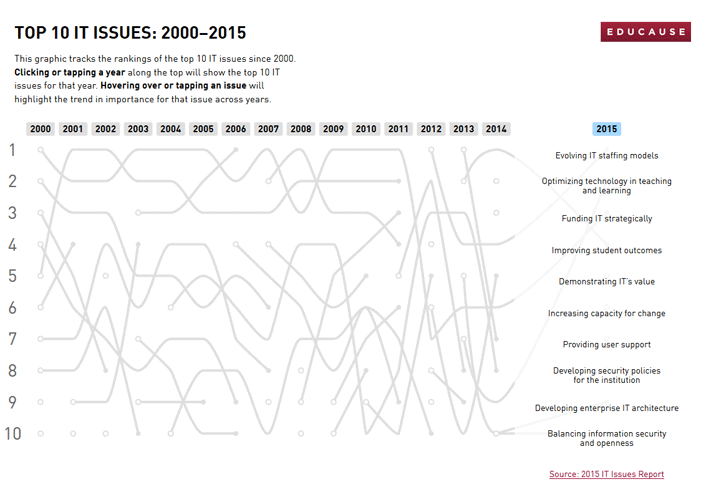
Change can be exhilarating and energizing, or it can be a vexing challenge—especially in the universe of higher education, known more for its timeless virtues than for its turning radius. Change can be difficult to talk about. And it can be especially difficult to accomplish. However, change is perhaps most troublesome when we talk about it but then do little or nothing to bring it about. This issue of EDUCAUSE Review offers several views of the change equation in higher education and of how technology can be a variable in that equation.
Some of the conversations in this issue capture the frustration, the sense of urgency, and the strong feelings involved when we talk about change. Whether expressing exasperation or evangelical zeal related to the way higher education has coped with or should respond to change, the voices accurately reflect our current realities. Strong feelings abound.
And so do persistent questions. When does change find traction? When does it fizzle out? What models will prevail, and which will lose their relevance? Technology naturally drives a great deal of excitement and consternation around change (recall MOOCS). Meanwhile, persistent financial challenges intensify our fears for what change might bring as our current models reveal themselves to be less and less sustainable.1
In the first feature article in this issue, Ryan Craig and Allison Williams emphasize that powerful, disruptive change is just around the corner—whether we are ready for it or not: "Colleges and universities have their work cut out for them over the next decade." The sea change they anticipate is seen through a lens that magnifies the lessons of Apple, Uber, and streaming music—industries in which "unbundling has driven fundamental change." Craig and Williams explain why and how they believe higher education institutions need to deploy both data and technology to face the "next seismic change in higher education: The Great Unbundling."
In contrast, Kenneth C. Green insists that in the higher education IT journey the more things change, the more they stay the same. Indeed, a review of the EDUCAUSE lists of the Top 10 IT Issues over the last sixteen years shows that many of the same issues appear and reappear in one form or another from 2000 to 2015. "Optimizing technology in teaching and learning," for example, comes and goes over the years, while "funding IT strategically" presents an unbroken thread in our IT fabric for as long as EDUCAUSE has tracked these issues.
Green's view is even more panoramic, spanning three decades—years marked by what he considers to be unrealized dreams linked to the failure to create and sustain the necessary "enabling infrastructure." Like Craig and Williams, Green notes: "The priorities for information technology in higher education for the next decade are clear." The challenges that lie ahead, he argues, are less about the technology and more about "the people, program, policy, planning, political, and budget issues that often impede implementation efforts."
These two conversations are provocative in different ways, with Craig and Williams warning us about the "Great Unbundling" ahead in higher education and Green critiquing the decades-long "Great Expectations" still left unrealized. The third conversation, Nancy Maron's article on the progress made in digitizing the humanities over the past decade, also looks behind and ahead while serving as a case study of successful change in a higher education IT field. In "The Digital Humanities Are Alive and Well and Blooming: Now What?," Maron offers a view that is both optimistic and pragmatic regarding the prospects for ongoing substantive change in the digital humanities. She explains: "This democratization of digital creation signals an exciting time, and yet it can pose institution-wide challenges as well." Acknowledging the seeds planted in the past, Maron outlines several models that could help the field continue to blossom in the future.
All the writers suggest, in their own ways, that the difference between talking about and realizing change comes down to the people involved. With people in mind, I can think of no better venue for continuing these and other conversations than the EDUCAUSE Annual Conference being held in Indianapolis on October 27–30.
Not sure you want to be "unbundled"? Let's talk about our challenges ahead as a community of colleagues and friends. Do you see a lack of progress in the IT innovations that matter to you? Let's hear from colleagues who have made demonstrable progress and documented results. Are you looking for models of success to help you move forward to the future? Let's share what we have learned and create communities of practices.
EDUCAUSE is committed to creating connections and enhancing decision making, and we do so by bringing people together virtually and physically. EDUCAUSE creates the space needed for questions, for answers, and for the great uncertain tract that lies between.
I look forward to seeing you in Indianapolis. Let the conversations begin!
Note
- Nearly 20 percent of chief business offers worry that their institutions are not viable in the long term. Kellie Woodhouse, "Closure Concerns and Financial Strategies: A Survey of College Business Officers," Inside Higher Ed, July 17, 2015.

John O'Brien is president and CEO of EDUCAUSE.
© 2015 John O'Brien. The text of this article is licensed under the Creative Commons Attribution-NonCommercial-NoDerivatives 4.0 International License.
EDUCAUSE Review 50, no. 5 (September/October 2015)

